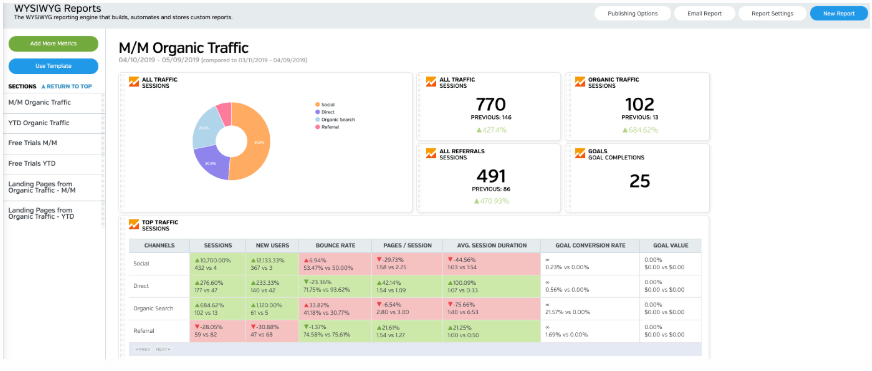Want to score absolutely insane results from your online marketing campaigns?
The answer is to optimize everything.
In this guide we show you how to tackle every aspect of the marketing matrix to ensure you achieve 360° optimization.
1. Identify your avatars
Before you even begin to market, identify your avatars. Not those little images that show up in your social media profiles. We’re talking creating a mental picture of your ideal client.
The reason? So that you can target your marketing to someone real. It’s easier to write copy for someone like your Aunt Martha or your teenaged son than for a faceless person.
Think about background, education, likes and dislikes to get a rounded picture of your ideal client. Mine social media data from Facebook or Pinterest to inform your persona strategy. The more detail you put in, the better you will be able to target your marketing and the more likely your marketing is to convert.
Then write it down (or you could try something new and make a Pinterest board). Check out Pamela Slim’s post on avatars to see how it’s done.
2. Psych out your customers
You’re probably not the only game in town, so why should people pick you? You may not BE better than the next guy, but using subtle psychological triggers can make your target customers believe that you are and encourage them to respond to your marketing.
For example, you can use the word ‘when’ in your copy to subtly promote the idea that it’s just a matter of time before your readers take up the offer.
Or encourage them to commit to your product with techniques like creating anticipation in your writing, answering potential questions up front, storytelling and providing incentives.
User-generated content like product reviews can also help build trust.
Put yourself in your customer’s head for a minute. She’s probably saying: “If people like me like this product, then I will too.” All of these tactics help people make the decision in your favor.
3. Test user experience
How your site works will directly impact whether people take up your offer – or even if they stick around long enough to find out what it is.
That’s why usability or the user experience (UX) is so crucial. That means how easy it is for people to use your site, find the information they want efficiently and remember it later and whether they are satisfied when they leave your site.
To find out, you need to test the heck out of your site and fix all the issues you find.
These include page speed, navigation, user interaction (heatmaps and analytics rule!), error testing, landing page testing, user surveys and accessibility. Here’s a big list of tools for testing usability, attention, clicks and more.
Sure, some of this seems a million miles from marketing, but if you get it wrong you won’t have anyone to market to.
You can also use A/B testing or split testing to try different versions of a page or Web copy simultaneously and see how people respond. Figuring out whether your signup box should be at the top or bottom, where to place your product video and which headline to use for conversion is also a key part of marketing optimization.
Visual Website Optimizer frequently writes case studies of how their customers use their split-testing tool to increase their conversions. This article shows how Underwater Audio increased their conversions by 35.6% with one test.
Test, tweak and repeat till you find what works.
4. Optimize for mobile
Optimizing your marketing for mobile isn’t optional, especially not if you’re marketing to tech savvy customers. As research from Forrester shows, a significant sector of the population has moved toward mobile adoption with more to follow. Everything we’ve said before also applies to your mobile customers, but you have to pay particular attention to UX and your copy itself.
In terms of UX, that means creating a site that’s either responsive or adapted to mobile.
Mobile optimization also applies to copy. While writing it tight has long been a feature of good Web copy, it’s even more crucial when people are viewing your site on smaller screens. Make sure your messages are customized for your mobile users, who are much more likely to make a quick buying decision than those using a PC.
5. Write great content
While we’re talking words, let’s discuss optimizing your writing. This is what tells a large part of your story, so you have to get it right. Think about:
- A headline that tells people what they’re going to get without putting them to sleep.
- Subheadings to make the copy scannable and help people find the sections they want.
- Content that’s easy to read for your audience. (Yes, you can test for readability, too)
- Keyword optimization – No keyword stuffing, but you can use one main keyword in your headline, a sub-heading and sparingly in the copy, wherever it fits naturally.
- A strong call to action that reinforces your “why” and tells readers what you want them to do next.
6. Market with video and images
Eighty-nine million – that’s the number of people who will watch a video today, says DemoDuck. If you’re not marketing with video, then your marketing strategy is half-assed because video helps people decide to buy.
People who won’t read your long form sales page will happily tune into the same information in video form. And Google research shows that as people move from screen to screen, one of the things they do is research products and shop. Tell your story with video or get left behind.
The point is to provide information to customers in the way they want to get it, so that means using all kinds of media. Create shareworthy images on Pinterest boards and encourage customers to re-pin them. Or put together an infographic – Piktochart is an easy tool for this – with interesting stats from your business or industry.
7. Test social campaigns
What happens after you send a tweet or share an item on your Facebook page? If you don’t know, then you have work to do in optimizing your social media presence.
This is not just about crafting great messages, sharing useful resources, using hashtags and creating a branded presence. While those are important, they are all wasted if you fail to analyze what’s happening on your social media accounts.
That’s why you need social analytics – they’re a not-so secret weapon that will tell you how your core market thinks, feels and acts on social media and what this means for marketing conversions.
Use analytics tools to troubleshoot your marketing campaigns and gauge customer response to what you share (and yes, you can split test social media messages, too).
Get these seven areas right, and you’ll soon have a rocking marketing campaign.

White Labeled and Branded Reports. Drag and Drop Editor. Automate your SEO, PPC, Social, Email, and Call Tracking Reporting.




